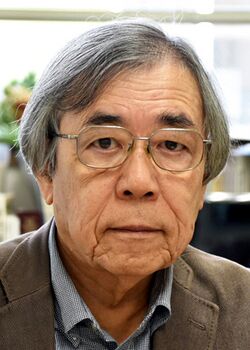Biography:Masatoshi Takeichi
Masatoshi Takeichi | |
|---|---|
 | |
| Nationality | Japanese |
| Alma mater | Nagoya University |
| Known for | Cadherin |
| Awards | Ross Harrison Prize (2001) Japan Prize (2005) Canada Gairdner International Award (2020) |
| Scientific career | |
| Fields | Cell biology |
| Institutions | RIKEN Kyoto University |
Masatoshi Takeichi (竹市 雅俊 Takeichi Masatoshi, born November 27, 1943) is a Japanese cell biologist known for his identification of the cadherin class of adhesion molecules, which plays important roles in the construction of tissues.[1] He shared the 2005 Japan Prize with Erkki Ruoslahti for "fundamental contribution in elucidating the molecular mechanisms of cell adhesion".[2]
He was selected as a Member of the Japan Academy (MJA) in 2000 and as a Foreign Associate of the United States National Academy of Sciences.
Early life and education
Takeichi was born in Aichi Prefecture, Japan, on November 27, 1943. He received his BSc in 1966 and MSc in 1968 from Nagoya University, and his Ph.D. in Biophysics from Kyoto University in 1973.[3]
Academic career
In 1970 Takeichi became a member of the faculty of Kyoto University, and he served as Professor of Biophysics from 1986 to 2002. During his time at Kyoto, he studied abroad at the Carnegie Institute Department of Embryology for a fellowship. In 2000, he was appointed as Director of the RIKEN Center for Developmental Biology (RIKEN CDB).[3]
Research contributions
In 1977 Takeichi discovered cadherin, and since then he has contributed to clarify its functions in tissue construction and to understand the molecular mechanisms of cell adhesion.[2] After his discovery of cadherins, he continued to research cadherins and their properties. Along with cadherins, he also researched cell junctions and adhesions. He continues to research at RIKEN today.
Discovery of the Cadherin Family
While first working in Kyoto, Takeichi was using trypsin to study cell adhesions and aggregation. Once he moved to the Carnegie Institution, he realized the trypsin he was using behaved differently. This trypsin solution contained EDTA, along with the trypsin, which disturbed adhesion. The EDTA sequesters calcium ions, so Takeichi began testing for adhesion dependent on calcium. He used Chinese Hamster V79 cells and treated them with a variety of treatments, including EDTA, trypsin + EDTA, and trypsin + calcium. Once treated, these cells were tested for aggregation levels. He found that both calcium dependent and calcium independent pathways existed, and that the calcium treatment prevent trypsin's effects on the cell.[1]
Takeichi knew there was calcium dependent molecule that served an important role, but he had to find it. Rolf Kemler's anti serum was what helped him finally identify cadherin. E-cadherin was the first of the cadherin family to be discovered. During this research, Takeichi also observed changes in the morphology of the cells involved with adhesions. He accurately hypothesized that the adhesions dependent on calcium played a role in managing cells' morphogenetic behavior. His discovery of the cadherin family led to a developing field of studying adhesions pathways.[1]
Other contributions
Takeichi, along with other scientists, studied the mechanism behind hemagglutinin from Botulism and its effect on the epithelial barrier of the intestines. They found the hemagglutinin directly interacted with the e-cadherin in the epithelial cells to disturbed cell to cell adhesion. This interaction like cell to cell adhesion is dependent on calcium ions. An assay showed the hemaglutinin interaction is specific to e-cadherin.[4]
Outside of cadherin, Takeichi studied other molecules involved with cell adhesion and beyond. He studied alpha-catenin functions outside of their functions within cell adhesion. The results showed alpha-catenin have a variety of functions outside of cadherin and adhesion. It regulates multiple different molecules, like actin and RhoGEF.[5]
Recognition
- 1994 Asahi Prize[3]
- 1996 Japan Academy Prize[3]
- 2001 Ross Harrison Prize, International Society of Developmental Biologists[3]
- 2001 Keio Medical Science Prize[3]
- 2004 Person of Cultural Merit[3]
- 2005 Japan Prize[2]
- 2012 Thomson Reuters Citation Laureates
- 2014 American Association for the Advancement of Science Fellow[6]
- 2020 Canada Gairdner International Award.[7]
Selected papers
- Takeichi, M (1977). "Functional correlation between cell adhesive properties and some cell surface proteins". J. Cell Biol. 75 (2): 464–474. doi:10.1083/jcb.75.2.464. PMID 264120.
- Yoshida, N.; Takeichi, M. (1982). "Teratocarcinoma cell adhesion: Identification of a cell surface protein involved in calcium-dependent cell aggregation". Cell 28 (2): 217–224. doi:10.1016/0092-8674(82)90339-7. PMID 7060128.
- Hatta, K.; Takeichi, M. (1986). "Expression of N-cadherin adhesion molecules associated with early morphogenetic events in chicken embryos". Nature 320 (6061): 447–449. doi:10.1038/320447a0. PMID 3515198.
- Nagafuchi, A.; Shirayoshi, Y.; Okazaki, K.; Yasuda, K.; Takeichi, M. (1987). "Transformation of cell adhesion properties by exogenously introduced E-cadherin cDNA". Nature 329 (6137): 341–343. doi:10.1038/329341a0. PMID 3498123. Bibcode: 1987Natur.329..341N.
- Hirano, S.; Kimoto, N.; Shimoyama, Y.; Hirohashi, S.; Takeichi, M. (1992). "Identification of a neural alpha-catenin as a key regulator of cadherin function and multicellular organization". Cell 70 (2): 293–301. doi:10.1016/0092-8674(92)90103-j. PMID 1638632.
External links
- [www.japan-acad.go.jp/en/members/4/takeichi_masatoshi.html Masatoshi Takeichi, Japan Academy]
- Masatoshi Takeichi, Foreign Associate of the National Academy of Sciences of U.S.A.
References
- ↑ Jump up to: 1.0 1.1 1.2 Powell, K. (2005). "The sticky business of discovering cadherins". The Journal of Cell Biology 170 (4): 514. doi:10.1083/jcb1704fta1.
- ↑ Jump up to: 2.0 2.1 2.2 Dr Masatoshi Takeichi, Laureate of Japan Prize
- ↑ Jump up to: 3.0 3.1 3.2 3.3 3.4 3.5 3.6 "細胞から個体へ - 脇道から到達した発生生物学の本流" Biography of Masatoshi Takeichi(in Japanese)
- ↑ Sugawara, Yo; Matsumura, Takuhiro; Takegahara, Yuki; Jin, Yingji; Tsukasaki, Yoshikazu; Takeichi, Masatoshi; Fujinaga, Yukako (2010-05-17). "Botulinum hemagglutinin disrupts the intercellular epithelial barrier by directly binding E-cadherin". The Journal of Cell Biology 189 (4): 691–700. doi:10.1083/jcb.200910119. ISSN 0021-9525. PMID 20457762.
- ↑ Takeichi, Masatoshi (2018-10-01). "Multiple functions of α-catenin beyond cell adhesion regulation". Current Opinion in Cell Biology. Cell Dynamics 54: 24–29. doi:10.1016/j.ceb.2018.02.014. ISSN 0955-0674. PMID 29525243.
- ↑ "Historic Fellows" (in en). https://www.aaas.org/fellows/historic.
- ↑ Gairdner Laureates 2020
 |

